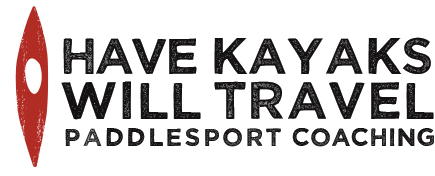Part of the kayak line-up before our Open Water Journeying course....
Buy my kayak! Avocet LV is perfect for smaller paddlers
The Avocet LV is one of the few boats suitable for smaller paddlers. There aren’t many performance sea kayaks suitable for very small paddlers. Many boats claim to fit kayakers who weigh less than 130 pounds, but few actually do. Most boats are too deep for shorter paddlers (a paddler’s hip bones should be just below the cockpit coaming) and too high-volume for lighter paddlers (increasing the amount of boat out of the water and making it more susceptible to the effects of wind). In the Avocet LV, a 110-pound paddler has proper trim. The Avocet LV is one of a handful of boats that actually fit Sharon. It’s fast and nimble, equally at home on a journey or in surf. It’s stable enough for beginners, playful enough for advanced paddlers, and highly responsive. The Avocet LV loves rough water. This boat is a 2008 with a built-in compass and a fiberglass keel strip. The skeg works, the hatches are dry, and it’s in good condition with only cosmetic blemishes. The deck is robin’s egg blue; the keel is white; the coaming and trim are quill grey. So why are we selling it? Because Sharon is now a Valley-sponsored paddler, and she has a new Avocet LV. So this one is for sale for $1900 (firm). Here are the specs: Length: 15’11” Width: 20’5″ Depth: 11.5″ Weight: 45 pounds If you’re interested, contact us at kayak (dot) bp (at)...
A full weekend of big waves and rough water
This has been a stormy start to summer in Chicago. We’ve had lots of rain and, to our delight, several days of strong northeasterly winds. Northeast winds yield big waves on the southwest side of Lake Michigan. Better yet, this happened over a weekend. And even better than that, we had a contingent of kayakers staying at our house. Paddling out into 5- to 7-foot waves during one of three weekend paddle outings. Mountains of water, and no other boats to share it with. The winds were in the 20- to 25-knot range for most of the weekend. One evening, we paddled into the wind for more than an hour, then turned around and paddled back in 15 minutes. North-facing beaches had excellent surf, though paddling out against the wind and the waves was a workout. Taking photos of surfing is uniquely challenging. It requires getting out of your kayak and snapping pictures while your friends continue playing in the waves. Some days we do it; some days we don’t. This time, we...
Blue skies, smiling at me, nothing but blue skies, do I see
You know that expression about how some people paddle with dark clouds over their heads, while others see only blue skies? That was our experience on Friday. Pat Rota paddles out under menacing clouds. Sharon focuses on the light at the end of the tunnel of clouds. Keith has no idea why we might be worried. Note: We had carefully monitored the weather and tailored the location and duration of our paddle accordingly. No kayakers were injured in the making of this blog...
Paddling in fog: a quieter experience on Lake Michigan
Paddling out through the fog. Warm air, cool water and still winds conspired to create fog along the shoreline on Thursday morning. The four-mile crib was invisible from Burnham Harbor. The only way to get there was to paddle a 67-degree course and wait for it to come into view. The fog-shrouded skyline behind us. Few sailboats bothered to venture out in such still conditions; motorboats and cruisers stayed in the harbor, too. We saw a couple of tour boats and heard communication on our VHF radios between them and the lock tender. Aside from that, we were alone on a very quiet lake. The four-mile crib came into view about half a mile from shore. We heard the fog horn long before we reached the crib. As we approached, we also heard the squawking and screeching of cormorants and gulls, who weren’t pleased to share their prime fishing ground with us. We weren’t interested in fishing, though. We came to swim. Alec pulls his boat through the water, demonstrating that we are all between swims. The fog gradually burned off, providing an interlude of blue skies before the cumulus clouds built above the city once again. By late afternoon, another in a series of summer storms came through, with strong winds and a deluge that contributed to the rising lake level (the optimistic way to view yet another storm that kept us off the water). In coming days, we’ll post photos of some of the rougher water that...
Photo Friday: Evidence of higher Lake Michigan water levels
Taking a photo below the surface near the breakwater at 12th Street Beach. The view below. A few months ago, the breakwater at 12th Street Beach was barely below the surface. Today, we had at least 18 inches of clearance. According to the US Army Corps of Engineers, water levels in Lake Michigan are up by a foot and a half. The June 27 level was 577.68 feet, up from 576.19 on March 1. Water levels were historically low at the start of this season due to last year’s record heat and drought, combined with this past winter’s lack of snow and ice. This spring’s record-breaking rain has been making up for those...
New course offering: Open water journeying!
Journeying along the scenic Chicago shoreline. This has been a busy paddling season, between the private lessons and club trainings we’ve offered, the coach trainings we’ve participated in, and our personal paddling adventures. This Saturday, Have Kayaks, Will Travel is offering an open-water journeying course, and spots are still available. This course emerged out of our experiences with friends and clients who want to paddle on Lake Michigan and have the basic boat-handling skills, but don’t always know how to: assess and mitigate risks pack for a day trip choose the right route use a VHF radio to communicate with lock tenders and large ships negotiate boat traffic launch and land in a variety of places solve problems and make decisions as needed to keep a group safe and have fun on the water. We’re going to coach these skills during a fun journey on the Chicago River, through the locks, and on Lake Michigan (though the exact route will depend on conditions that day). Date: Saturday, June 29 and Sunday, July 7 Time: 8 a.m. to 3 p.m. Distance: 10 to 12 miles Cost: $125 To register or for more information, contact us at kayak.bp@gmail.com and please include a phone number so we can call you...
A Father’s Day poem for paddlers
To all of you dads who would rather be paddling than opening gifts amid family prattling. To all of you dads, be you homely or dashing, who want to get out on waves cresting and crashing. I hear you, I get it. I feel the same way. But I think you should hang with your family today. (Unless, of course, your kids paddle, too. In that case, get out! This poem’s not for you.) Think for a moment of all they have done to allow you to paddle and have so much fun. They put up with your gear hanging in the back yard. They tolerate neoprene stink– and that’s hard! They squeeze past your kayak to get to the car. They don’t laugh aloud when you say “pub” not “bar.” They let you buy rescue knives, tow belts and flares, and assemble your kits for first aid and repairs. They know all the acronyms: CLAP, PFD BCU, ACA VHF, LTPD. They deal with the sand and the water and dirt. They’re even OK with you wearing a skirt. So stay home and celebrate family today. Hang out with your kids. Hear what they say. For despite your addiction to paddling, it seems, your children still love you. You’re the dad of their dreams. ...
Photo Friday: Another excellent use for duct tape
A buoy outside of Jackson Harbor in Chicago. A little bit wonky, but we guess it...
10 tips for prolonging the life of your drysuit
Forget tuxedos and gowns. Our drysuits are our most treasured (and most expensive) garments. Treating them well can lengthen their working lives and ensure that they perform their jobs perfectly. We checked in with Matt Porter, Product Manager and Customer Service Supervisor at Kokatat, for advice on extending the lives of drysuits. His advice: 1. Keep your drysuit out of direct sunlight whenever possible. UV degrades both Gore-Tex and latex, shortening the life of the fabric and the gaskets. 2. Avoid insect repellent and sunscreen. DEET is particularly destructive of latex gaskets; sunscreen is also rough on them, so apply it at least 15 minutes prior to putting on your drysuit to allow the sunscreen to soak into your skin. When you reapply, avoid getting it on the gasket. 3. Rinse your drysuit in fresh water, with the zipper closed, after paddling in salt water. Hang it to dry on a wide hanger with the zipper open one or two inches. 4. Clean your drysuit with fresh water. If it smells bad, use a drysuit shampoo or a gentle, bleach-free laundry soap. 5. Never put your drysuit in a top-loading washer; the agitator may rip it. 6. Lubricate metal-tooth zippers with hard wax; use non-wax lubricants on plastic zippers. Plastic zippers should be lubricated every other time you wear your drysuit. 7. Protect drysuit booties by wearing socks and being careful not to walk or stand on surfaces that might damage them while you’re changing. 8. Transport your drysuit loosely rolled with the zipper open one or two inches. 9. Store your drysuit in a dry area on a wide hanger with the zipper open one or two inches. 10. When the DWR wears out (and it will!), try ironing the Gore-Tex fabric on the nylon setting to reactivate it. If you decide to re-waterproof it, use a spray-on product, not a wash-in product, so that it doesn’t get on the inside your drysuit. Dry it with an iron (on the nylon setting) or a hair dryer; never put your drysuit in a clothes dryer. Routine maintenance, such as gasket replacement, can be done at home. Other repairs, such as leaks and tears, should be done by the...







